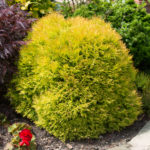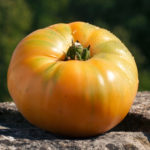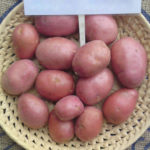Rosa Louis de Funes
The brighter the flowers in the garden, the better the mood of its owner. If you are of the same opinion, plant a rose on your site that bears the name of the great comedian Louis de Funes. It will fill your soul with light and become an inexhaustible source of inspiration and vitality for you.
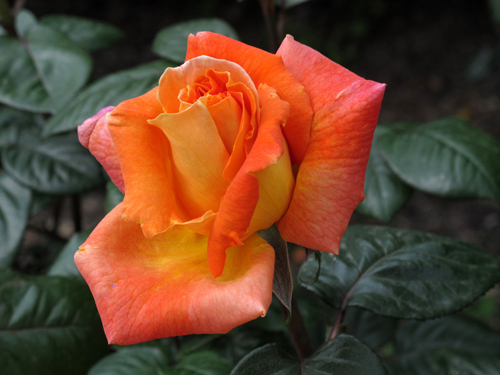
History of origin
Louis de Funes was bred according to some sources in 1984, according to others - in 1987. It is the brainchild of the French company Meilland Internation. The variety also has other names: Charleston 88, MEIrestif. The actor, after whom the culture was named, personally chose it for himself during a visit to the company's rose garden, which is located in the town of San Rafael near Nice. He expressed his admiration for the shade of the buds of the plant and compared this color with a sunny day prevailing in the south of France, where he had visited more than once in connection with the filming of numerous films.
The flower has received many awards in its time. This is a gold medal and the title "Golden Rose", awarded to him in the Italian Monza, as well as a gold medal, which was awarded to the variety in Geneva, Switzerland.
Description of appearance and features
As you may have guessed by now, the shade of Louis de Funes' colors is yellow. Others describe it as tangerine, yellow-orange, light orange, apricot, peach, nasturtium color. In any case, the color of the buds of this culture is very juicy and rich. The flowers of this variety are single, large, from 12 to 15 cm in diameter. They are formed by slightly twisted petals with a wavy edge in the amount of 48 pieces. In this case, the petals located on the periphery of the flower are large in comparison with the rest. The buds of an elegant beauty cannot be called densely stuffed. Nevertheless, the middle of the flower is reliably covered with petals from prying eyes. The rose blooms for a long time and abundantly throughout the season: from June to the end of September. A lot of buds are formed on the bush at the same time, blooming very slowly. A pleasant aroma is felt near the plant during this period, which can be regarded as a mixture of honey and lavender notes.
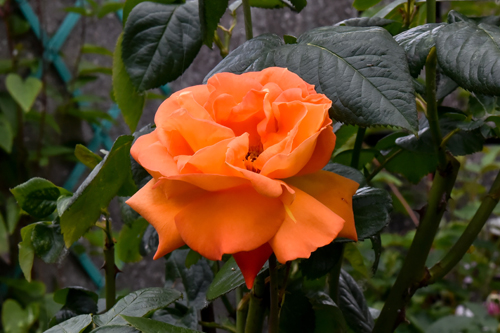
The culture itself is a vigorous shrub up to 1 meter in height. Its slender shoots are practically devoid of sharp thorns. The leaves of this plant are tough, bright green, shiny. The variety has an average resistance to diseases, is distinguished by a high level of winter hardiness, shade tolerance and drought tolerance. Its flowers are not afraid of rain, but fade in the sun, although outwardly they do not suffer from this - they simply change their original shade to a redder one, while the tips of the petals become crimson. Louis de Funes does not need to be covered for the winter, and its stems do not need to be tied up.
Growing and care
The hybrid tea rose feels comfortable in sunny places with a little shade during the hours of the greatest activity of the sun. Due to its good shade tolerance, Louis de Funes can grow in the shade, but in this case, the perennial flowering will not be so luxurious.
Our hero is not particularly capricious, but he needs full care. During the period of active growth, as well as in the budding phase and at the peak of flowering, the plant should be watered intensively, the rest of the time - moderately. Make sure that the soil under the rose bush does not dry out - this can lead to partial leaf fall, deterioration of the quality of flowers and a decrease in the size of the buds. Soil flooding is also recommended to be avoided. After watering several times a month, the area of the near-trunk circle must be loosened, followed by mulch (best with humus). Thus, you will protect the earthen lump from overdrying and overheating, retain moisture in the soil.

At the beginning of the active growth phase, that is, in the spring, the rose is fed with nitrogen fertilizer. It is prepared independently from 10 liters of water, 10 grams of urea and 20 grams of nitrate. When the buds begin to set on the plant, the perennial is fed with a mineral concentrate with a high content of potassium and phosphorus. In the springtime, the hybrid is subjected to planned pruning, removing weak, too thin and dry shoots. In order not to be mistaken, this procedure is performed with the onset of the period of sap flow. For the winter, the healthy stems of Louis de Funes are shortened, the sick and the dead are removed, the foliage is cut off. This event is held at the end of October.
It is not necessary to shelter Louis de Funes during the cold season. But if you want, you can sprinkle young specimens with peat and cover with spruce branches on top. To reduce the risk of powdery mildew on the rose, treat the bush with a fungicide solution three times during the spring-summer season.
Use cases
The French variety looks equally good in single and group plantings. If you plant it in the foreground of the site or on the lawn, it will undoubtedly become the object of everyone's attention. In the compositions, the plant is combined with lilac, cotoneaster, yellow acacia, snowberry, euonymus, scumpia, tamarix, privet, sucker and other deciduous crops. From conifers, juniper, thuja, miniature pine, spruce will become excellent companions for the European beauty, from herbaceous crops - flowering mono- and perennials with flowers of blue, blue, lilac and purple shades.
The variety is appropriate in rabatkas, mixborders, in the parterre, in the borders on the sides of garden paths. The rose is also used in cut: the bright flowers of Louis de Funes stand in a vase of water for up to 14 days.
